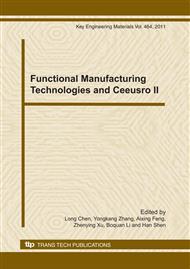p.623
p.627
p.632
p.637
p.642
p.647
p.651
p.655
p.660
The Analysis about Double-Wall Carbon Nanotubes Resonant with the Phenomenon of Energy Dissipation
Abstract:
In this paper, the double-wall carbon nanotube oscillator resonant phenomena and energy dissipation are simulated by use of molecular dynamics simulation. The simulation run at different temperatures , and the double-walled carbon nanotube oscillator resonance phenomenon is verified,the vibration displacement curve which carbon tubes versus time and the changes in restoring force of carbon tubes suffered in the process of oscillation process are obtained and the friction is discussed from the point of view of energy dissipation. By statistical calculation, the double-walled carbon nanotube resonant amplitude of the process is found quickly decay with temperature increasing, and the friction per atom will enlarge with temperature increased, but the restoring force of inner tube is almost constant.
Info:
Periodical:
Pages:
642-646
Citation:
Online since:
January 2011
Authors:
Price:
Сopyright:
© 2011 Trans Tech Publications Ltd. All Rights Reserved
Share:
Citation:


